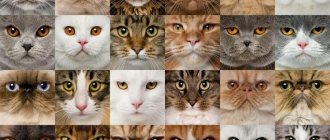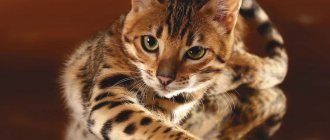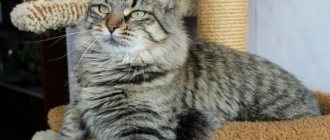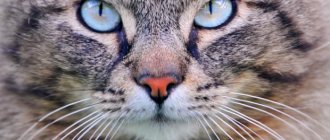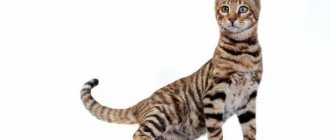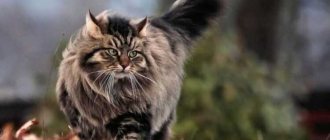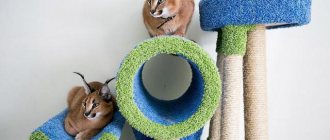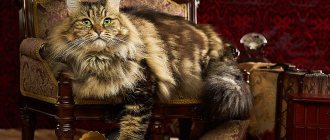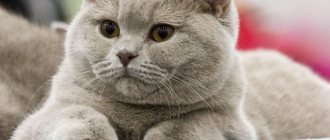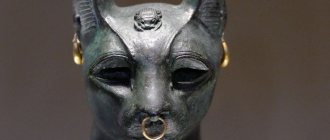The variety of cat breeds amazes the imagination of novice felinologists. All of them differ from each other not only in the character, size and structure of the muzzle, but also in the structure of the guard hair. And if even kids know about fluffy Persians, hairless sphinxes and plush British cats, then not everyone knows about the existence of curly cats.
Let's figure out which breeds have curly hair.
Cornish (Cornish) Rex
This is an agile, graceful cat on slender legs, with a wedge-shaped head, huge ears, and a thin and long tail. The fur of the Cornish is very short - from a distance it seems that it does not exist at all, but it is quite dense. Curly hair looks like neat waves that spread evenly from the top of the head. The colors of the Cornish are very different - the standards allow almost all existing ones. This is the oldest breed of curly cat.
The progenitor of the breed is a mongrel cat born on a rabbit farm in the English county of Cornwall in 1950. And if N. Ennismore (the cat’s owner) had not been a breeder, albeit a rabbit one, it is unlikely that the felinological world would have seen a new breed. Ennismore drew attention to the unusual kitten and tried to fix the interesting mutation. And soon breeders from America became interested in her work.
Ennismore suggested naming the curly-haired cats “after” the rabbits – a breed called “Rex” was bred on the farm. After some time, the name of the county was added to it, the birthplace of the first curly-haired cat. Since then, all mutations that make a cat's fur crimped are called rexoid.
Character and socialization
In fact, the breed is ideal in every way. All its representatives get along well with children and are on friendly terms with other animals, if any. Selkirks are always friendly, affectionate, sociable and playful. They love to be near a person and participate in all his affairs.
We can say that this cat brought together into a single whole the character of the breeds that participated in its breeding. The British gave them calmness and some phlegmatism, although the Selcreek is much more active and mobile, which makes it similar to exotics; they inherited fluffiness and independence from the Persians. Sometimes owners describe them as affectionate, submissive, but at the same time slightly stupid pets.
Despite their patience and affection, pets do not particularly like to be petted. At the same time, they love to communicate and hate being alone for a long time
If necessary, attract attention with a quiet but firm voice
Video about Selkirk Rex cats:
KotoDigest
Thank you for subscribing, check your inbox: you should receive an email asking you to confirm your subscription
Today there is a huge variety of cat breeds. Some of them are natural, while others were artificially bred by breeding scientists. That is why such animals are very popular and often become pets - each person can choose a cat depending on their individual preferences and needs.
There are breeds with long and short hair, hairless cats, tri-colored and solid
If you are looking for an unusual pet, then you should pay attention to curly-haired cats. A distinctive feature of such pets is their non-standard wavy coat.
What are the characteristics of curly-haired cats, what breeds exist, in what conditions should such a cat be kept, how to care for its fur - let's talk in more detail.
Why do curly-haired cats have such a special coat?
Curly, wavy hair is the result of a spontaneous mutation of the genes responsible for the cat's hair. Breeders have noticed that cats of different breeds can give birth to kittens that have soft curls, while other babies from the same litter have straight hair.
By crossing curly-haired individuals with each other, it was possible to create breeds in which the curly gene became dominant. The study of this feature is complicated by the fact that different genes may be responsible for the unusual hairline.
Devon rex
Representatives of this breed have a strong muscular body, long legs, a large head with huge, low-set “elven” ears, a seemingly surprised look in large eyes and a slightly snub-nosed muzzle. The Devon's short coat is arranged in loose curls.
The history of the breed began in 1959. Animal lover B. Cox from the English county of Devonshire took “patronage” over a recently lambed street cat. How surprised she was when she noticed that one of the kittens was covered with curls! Of course, the unusual kitten took the “position” of a pet.
Once in one of the newspapers she saw an article about the Cornish, a curly-haired cat who made a splash at a cat show. Miss Cox felt that her pet deserved no less admiration. But no one expected that he would become more famous than could be imagined.
A cat from Devonshire attracted the attention of a Cornish breeder, B. Stirling Webb, and was invited to participate in breeding work. Imagine her disappointment when absolutely all the offspring of Miss Cox’s cat were born with ordinary hair. However, felinologists soon found an explanation - the curly fur of the Devonshire cat is caused by a completely different gene. And they decided to breed a new breed.
Features of keeping and caring for curly-haired cats
Breeders of curly pets note that their coat, contrary to expectations, does not require specific care. It is soft, does not tangle, and does not cause allergies. It is enough to brush the animal regularly to keep it looking neat.
Most Rex cats do not have congenital genetic diseases. It is enough for them to eat a healthy and balanced diet, preferably premium and super-premium food.
Cornish Rex
A distinctive feature of all curly pets is their sociability and friendliness. Rexes cannot stand loneliness; they constantly cuddle up to their owner, rub their legs, and jump on their laps. Some people prefer to sit on the person's shoulder, closer to their face. You should not get such a cat if family members spend most of their time at work. But a curly pet will fit perfectly into a large family with children.
Share with friends!
Breeding
The first estrus in females occurs at 9 months. But Cornish Rex cats do not begin to mate earlier than 1 year, since before this time the animal’s body has not yet fully formed and is not ready for gestation. As a result of mating too early, the offspring are often born weak and non-viable. All necessary vaccinations must be given in advance (4-5 months in advance).
Experienced breeders do not recommend breeding females before 1 year of age
The female is brought to the male's territory and left there for several days. It is better to cut the cat's claws so that she does not scratch her partner. If after a month the heat has not started, then everything went well. The duration of pregnancy is from 62 to 66 days. Usually there are no complications and childbirth is easy. Small Cornish cats are first covered with small light curls, then at about six months they shed and become overgrown with real, denser wavy hair.
From personal experience. My office neighbor had a Cornish Rex cat at home. She didn't have any documents. Bought second hand based on an ad. She was worn to mate with a purebred cat about once a year. The kittens in the litter were very different in color, but usually no more than half of them were wavy.
Selkirk rex
Externally, Selkirks are noticeably different from Cornish and Devons, since the British and Persians were involved in the selection of the breed. Their appearance resembles fluffy soft toys; they are often called sheep and bear cubs. Selkirks inherited from the Persians not only strong bones and a calm character, but also luxurious long hair. However, the breed standard allows for a short one, “British heritage”.
Like the representatives of the two previous breeds, the Selkirk has only a common ancestor - a cat born in one of the American shelters in 1987. And as always happens in such cases, if one of the employees had not noticed the curly-haired kitten, and most importantly, had not told the experienced felinologist D. Newman about it, there would have been no Selkirks. Newman found out that the animal’s curly hair was caused by a new, unstudied gene, and decided to create a new breed.
Interesting Facts
- Many LaPerm cats are calm about water; they can easily frolic in the rain or even swim in the bathtub.
- This is one of the most talkative breeds. They can compete with Orientals and Siamese cats, however, unlike those, LaPerms have a quiet, non-irritating voice.
- The fur of these cats has a number of specific properties. Laperms are hypoallergenic, since they do not have an undercoat, and the curling hairs prevent the excessive loss of particles of dead epidermis (the top layer of skin).
- Representatives of this breed are characterized by total shedding, when they completely lose their hair. This phenomenon is reversible and after some time the pets again grow new hair, which curls again as it grows.
- Since LaPermas are extremely intelligent cats, they quickly remember their name and quickly begin to respond to it. Also, if you properly interest your cat, you can teach it to perform some tricks.
- Starting from 2021, they plan to ban crossing LaPerm with other cat breeds in order to consolidate appearance traits, and felinologists will have the right to resort only to intrabreed crossing.
Appearance
Devon Rexes are relatively small, the weight of adult cats is 3.5-4.5 kg, and females - 2.3-3.2 kg. But despite their fragile appearance, they are agile, strong, highly muscular animals that use their long legs for quick starts, sharp turns and enviable high jumps. The head of Devons is large, wedge-shaped, the ears are large and set high. The eyes are expressive oval.
Wool comes in different variations: from light ripples to large rings. The hair is soft and thin. Molting is very weak. There is an opinion that the breed is hypoallergenic, but this is not true. Devons can cause allergies, it just happens much less frequently.
Hypoallergenic
Although many breeds of curly-haired cats are considered hypoallergenic, this is not always true. Therefore, it is worth consulting not only with the breeder, who may be unscrupulous, but also with a veterinarian. After all, allergens are contained not only in fur, but also in saliva, urine, and animal skin. It is worth considering the origin of these breeds and remembering their parents. And if you have an allergy, you should think it over several times, weighing the pros and cons.
Cats with curly hair are gaining more and more popularity, and the number of people wishing to purchase such an interesting pet is constantly increasing. And this is no coincidence. They are truly incredibly beautiful. But not only the appearance attracts breeders, but also the unique character that is inherent in absolutely all these cats. They are very affectionate, obedient, love all family members and will become excellent friends for kids. But you should buy such a kitten only if it is possible to give him the same thing in return. These pussies need affection, love and understanding.
Laperm
This is a harmoniously built medium-sized cat, with soft, very pleasant to the touch curly fur and a wonderful, affectionate and friendly character. All lapermas are descendants of a rat-catcher cat, born on an ordinary American farm in 1982. The newborn immediately attracted the attention of the owner of the farm, L. Coel, as she was completely bald.
However, by two months, the wrinkled body began to be covered with long curls, and soon the cat turned into a real beauty. Coel did not understand either genetics or felinology. However, after reading the relevant literature, I realized that I had encountered an unknown rex mutation.
True, in the next decade, the descendants of the amazing cat crossed with each other (and with other cats) as they had to, without control from Coel. But when breeders became interested in the mutation, there were no problems with the breeding material - the population increased noticeably, all the cats were distinguished by good health, friendly character, and most importantly - genetic diversity.
Officially registered breeds
If, when breeding cats, individuals with a non-standard appearance appear, then it is not enough to simply engage in their further breeding. For a breed to be registered, it needs to be recognized by international felinological communities and develop standards for it, which can take several decades. There are several officially recognized breeds with curly hair: rexes and lapermas. You can see what they look like in the photo below.
Rex varieties: German, Selkirk, Cornish, Devon, Ural
There are several varieties of rex:
German Rex
- German Rex. The short-haired breed is considered the first among the rexes. The first kitten appeared in the 1930s. in the territory of East Prussia in a litter of Russian Blue and Angora cats, but the breed was officially recognized only in 1982. The physique of the German Rex is average, muscular. The head is rounded, the cheeks and chin are well developed. The ears are set wide apart, wide at the base and rounded at the tips. Any coat color is allowed, except those obtained as a result of hybridization - chocolate, fawn, cinnamon. In addition to curly hair, it has curly whiskers. Disadvantages include an innate tendency to allergies and obesity.
Siamese-Oriental Shorthair
The eastern group of cats includes Oriental and Siamese breeds. Their head is triangular in shape, there are almost no cheeks, and the chin smoothly turns into ears - very large and high.
The neck is set high, the body and tail are long. Such characteristics make this group strong, beautiful and unique.
In order not only to preserve, but also to improve the above-mentioned cat breeds, as well as to avoid their degeneration, many breeding programs provided for interbreeding of Oriental and Siamese animals.
This is due to the fact that both breeds have almost identical morphological characteristics, differing only in color. Another common characteristic of these cat breeds is the lack of undercoat. And even if there is one, it is thin and short.
Important! Siamese pets are characterized by a different temperature type of color, while Oriental pets do not have such a color regime.
The Oriental cat appeared after the end of World War II
At that time, the attention of many animal lovers was directed to new cat species. Oriental pets differ from Siamese in a wide range of colors.
Pedigree oriental cats, photos and names of which can be seen below, are characterized by a refined skeleton, but at the same time a strong physique
In these breeds, excitation usually prevails over inhibition. They are known to be active and at the same time affectionate animals.
They are characterized by jealousy, as they really love the attention of their owner. You can’t raise your tone and shout at these stylish cats, because they can react with nervous breakdowns
You should be calm and calm when dealing with such pets.
Best articles: Yam BK ointment for cats: description, scope, as well as advantages and disadvantages
The following breeds belong to the group of Siamese-Oriental cats.
Balinese or Balinese breed, originally from the USA. It gets along well in families with children, as well as in places where the owners are often at home.
Mekong (Thai) Bobtail. The first individuals were brought from Asia. The breed is completely native and has a short tail. The cats are very muscular and have a fairly strong build. The claws on the hind legs do not retract. The coat is short and very shiny, there is undercoat, but it is minimal. The pets are balanced, love affection, and quickly and strongly become attached to their owner. It is advisable not to include fish in your diet.
Oriental Shorthair. The country of origin of this breed is Thailand. The pet is sophisticated and elegant, has a long tail and limbs. The muzzle is also slightly elongated. Did you know? Cats are capable of producing approximately 100 different sounds. Dogs, by comparison, produce only 10.
The grace of the animal is emphasized by the smooth, tightly fitting fur. There is no undercoat. The cat does not like loneliness and is very attached to its owner. So it is recommended to keep it for people whose family will always have someone at home.
The Siamese cat comes from Thailand. An excellent option for those who do not keep any other animals at home. The pet is small in size and has a flexible, elongated body. The muscles are especially well developed. The animal is active and very sociable
You need to keep in mind that the Siamese cat cannot stand being alone, so you need to pay attention to it more often
Thai. As is clear from the name, the country of origin of this breed is Thailand. The animal is compact but strong. The head is round in shape, the legs are developed and quite thick. The pet is extremely smart and fearless, and can be trained quickly. It can make various sounds, which is why it is sometimes called a “talking cat.” She is distinguished by her expressive facial expressions and is interesting to watch.
Tonkin. Originally from England. Suitable for families with small children, as this cat gets along well with them. She is smart and playful. She is gentle with her owner and quickly becomes attached to him. At the same time, he willingly makes contact with other people. It can also quickly make friends with other cats that live in the house. She can live in an apartment, but in this case it is advisable to provide her with a walk.
Ural rex
Ural cats are large slender cats with a short muscular body, medium-length legs and tail, a plump muzzle and neat ears. The fur of the Ural cats is quite thick, soft and pleasant to the touch. The latest version of the breed standard allows for both long and short coats.
As already mentioned, rexoid mutations have been seen in different parts of the world. There is such a place in Russia. Curly cats were and are found in the vicinity of Yekaterinburg. However, the “founding father” of the breed, called the Ural Rex, is one cat born in 1988.
History of the origin of the breed
In 1960, near an abandoned mine in Devonshire, an unusual couple was first noticed: a cat and a kitten with beautiful wavy hair. Some time later, the cat disappeared, and his companion was sheltered by kind people, to whom she gave a litter of kittens. Among all the babies, only one had wavy fur; this black cat was named Kirli, which means “Curly”. It was Kirley who became the first officially registered Devon Rex.
Germanic (German) rex
This is a well-proportioned cat, with a strong body, slender legs, a rounded head and large ears with rounded tips. The coat of the Germans is short, plush, with a clearly visible curl.
There is no reliable information about the ancestors of the breed. According to one version, all Germans descend from a cat born in the vicinity of Königsberg. Experts treat the Germans differently. Some felinological systems recognize them, others do not see significant differences with the English Rex breeds. Meanwhile, the difference in the appearance of the Cornish and Devon is obvious.
To date, about 20 different rex mutations have been registered. Based on almost every one, enthusiasts have tried or are trying to breed a new breed. Is it worth doing this, since it has already been proven that some “curly” genes do not have the best effect on a cat’s health? Probably not worth it. Nevertheless, the desire to create something of your own, special, often defeats common sense.
Didn't find what you were looking for? Use the site search form
Skookum
A young breed of curly-haired cats, which appeared as a result of crossing laperms and munchkins. From the latter they got shortened legs, from the Laperms they got sloppy fur sticking out in all directions. Skookums have a short, wide muzzle, which makes even adult cats look like kittens. In the lane from the Indian "skukum" means unbending, powerful.
Short legs do not prevent them from running quickly, deftly climbing trees, and jumping to heights. The cat short-legged gene is not associated with diseases of the musculoskeletal system. The character is like that of munchkins - active, playful, sociable. Skookums are curious and enjoy playing with children and meeting strangers.
Price
You can buy laperm cats in Russia only in one nursery (Russicurl). They are mostly distributed in the USA, Japan and Australia. Being a fairly rare and unique breed, the price of curly-haired cats starts from 70-80,000 rubles. The price is influenced by the cat's pedigree, rarity of color and other unusual features.
It is recommended to purchase laperm kittens after reaching 4 months, since this is when they develop characteristic features that will allow you not to make a mistake when choosing.
LIFE HACK: You can buy laperm kittens with straight hair. In the future, curly-haired kittens will definitely appear in the offspring. Since the curly gene is the dominant gene, and it is passed on in every generation. But, before you buy, make sure that they are selling you a cat of this particular breed.
Tibetan
A cat named Llama, brought by Mrs. McLaren Morrison from Tibet, is the earliest known curly-haired cat. The London Evening Standard, October 19, 1892, writes: “A unique specimen from Tibet, which was the first ever exhibited. This animal is black in color, with curly hair that looks more like hair than fur. The Illustrated London News of October 22, 1892, gives the following description: “The only entirely new phenomenon at the exhibition was a cat, which was imported from Tibet. She is small, black, with curly fur, very similar to the short hair of a Negro.”
Mrs. McLaren Morrison collected unusual cats. The llama had no recorded curly descendants
. Perhaps she never gave birth or her offspring were straight-haired. At the time, cat breeders did not understand recessive traits and that backcrossing could restore them.
Care
Selkirks shed a lot, so they need to be brushed regularly.
The unusual texture of wool does not require supernatural efforts to care for it. It is enough to brush your pet 2 times a week to remove tangled hair. Selkirks shed a lot, and regular brushing will remove dead hair. Otherwise, all furniture and clothes will be literally covered with wavy pile. During home grooming, the curls are straightened with your fingers to fluff them up and give the animal an even more glamorous and cute look.
It is not necessary to bathe pets, unless the cat is very dirty or is expected to be shown at an exhibition. After water procedures, the animal should dry naturally, but the process should take place in a dry, warm and draft-free room so that the beauty does not catch a cold. Using a hairdryer is not recommended because the Selkirk's coat will look more like a disheveled poodle than a real doodle, which is what it should be.
The remaining grooming procedures are standard and do not differ much from those used when keeping other breeds of cats:
- To prevent periodontal disease, brush your teeth at least once a week;
- Treat the corners of the eyes daily with a soft cloth to remove dried crusts. It is important to use different swabs for each eye;
- Check the ears once a week; if dirty, wipe the inside of the sink with a swab dipped in warm water. There is no need to go deep into your ears; you should not use cotton swabs for this purpose, so as not to damage the inner ear.
Many breeders recommend keeping Selkirks exclusively in an apartment or house; this will not only help protect pets from infection, but also prevent accidents (attacks by stray animals, theft, getting hit by a car, etc.).
Useful information for potential owners
Caring for curly-haired felines is no more difficult than caring for individuals with regular fur. They are provided with a balanced diet, timely veterinary care, routine vaccinations and hygiene procedures.
Curly-haired cats are systematically combed with a special comb and brush. Otherwise, the animals will look unkempt. Such pets are bathed using shampoos for curly hair, and dried without using a hair dryer.
Curly cats attract attention with their unusual appearance and forever captivate with their good-natured, loving disposition. Therefore, it is not surprising that interest in breeds with curly hair is steadily growing.
I like it I don't like it
Psychological picture
Selkirk Rex is a wonderful breed of companion cats, friendly and sociable, loving human company and fun outdoor games. They are very patient and gentle, treat all members of the family in which they live well, do not conflict with pets, and live peacefully. Selkirks value communication with their owner most of all, they cannot live without it, and they become very attached to the owner, therefore it is strongly recommended not to leave Selkirk Rexes alone during the long absence of the owner. These cats love to be the center of attention, they really love sitting in the arms of the owner, hugging and scratching behind the ear.
Longhair
The long-haired group includes a lot of cat breeds. Their distinguishing feature is the type and length of their coat. A certain number of long-haired animals were formed by the will of nature, and some were bred through selective breeding.
Researchers have tried to improve the beauty and vitality of these pet representatives.
When caring for a cat, it will be useful for you to learn more about how to mate cats, why cats need clothes, how to choose a carrier for cats, how to make a scratching post, how to sterilize, how to trim claws and what a furminator is needed for.
There are variegated cats, color-point cats, and options with white. New variations also appear thanks to breeding work.
Important! Compared to other cat groups, these cats have a wider chest, but their limbs, on the contrary, are slightly smaller in size. Due to such body features, they often rest rather than lead an active life. The most popular representatives of this group of cats are the following:
The most popular representatives of this group of cats are the following:
Persian cat. It appeared in European countries around the 80s. At first, she was almost the only representative of exotic cats. Currently, thanks to breeding work, the Persian breed can be colored in 100 or more different shades.
Bohemian Rex. Relatively recently it was recognized in Czechoslovakia. The soft fur is not just long, but also curly. The first cats appeared in the 80s of the last century.
Dwarf cat Napoleon. The breed is unique; it was bred through selective breeding. For this purpose, Munchchins and Persians were crossed. This selection was initiated by Joe Smith, a breeder from the USA.
Top articles: Russian Blue cat
British Longhair. A calm and friendly cat, she loves children very much, but she walks away from excessive imposition with dignity. To prevent a feeling of permissiveness, it is not recommended to pamper such longhaired representatives.
Himalayan. A long-haired representative with a color-point type. It was developed in the USA around the 50s. For this purpose, Siamese and Persian breeds were crossed.
York chocolate cat. An affectionate and very playful animal. Quite quickly he gets used to the people to whom he gives his love and tenderness.
Nibelung. The breed was developed in the 1980s in America. Cats were recognized as the main felinological associations only in the 90s.
Chantilly-Tiffany. Beautiful and slender felines. The fur is silky and very soft. There is practically no undercoat, so the wool does not roll into tangles. By nature, these pets are patient and balanced, and they love active games with their owner.
Javanese. The Javanese cat is intelligent and loves to play. She loves to communicate with her owner, and she is also interested in watching how the owner goes about his business.
